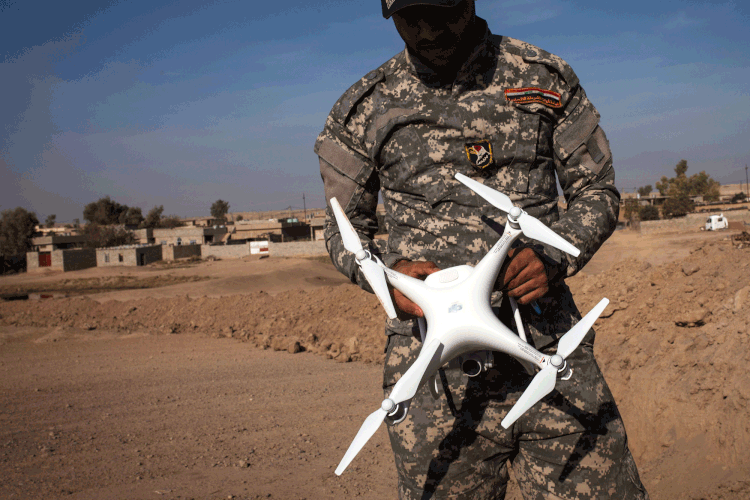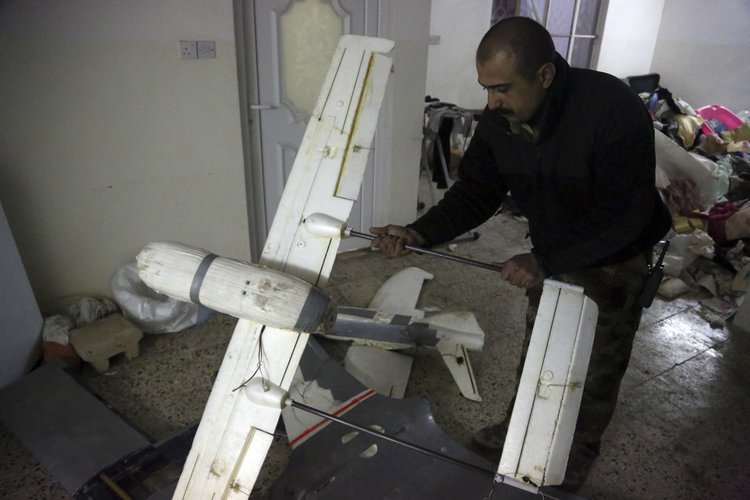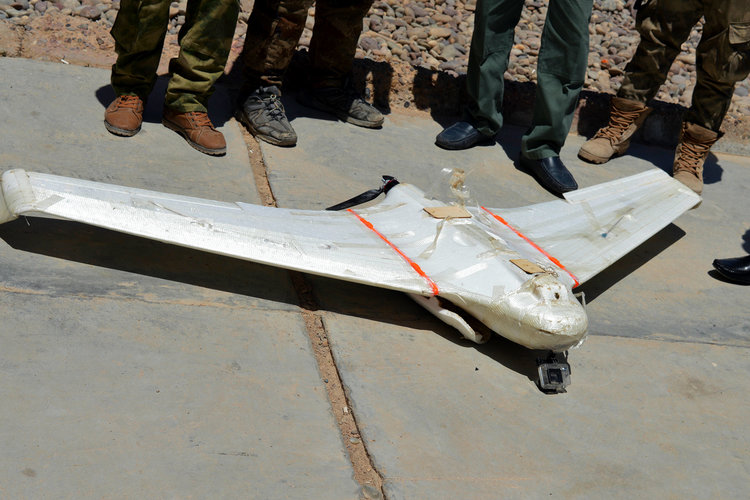By Mark Jacobsen
This essay is part of the #WarBots series, which asked a group of academics and national security professionals to provide their thoughts on the confluence of automation and unmanned technologies and their impact in the conduct of war. We hope this launches a debate that may one day shape policy. Over the past year, a primitive type of WarBot has become a formidable battlefield weapon: the small unmanned aerial system. The threat materialized in October 2016 when a drone booby-trapped by the Islamic State killed two Kurdish soldiers. Within a few months, the Islamic State was flying tens of aerial bombardment missions each day, displayed the capability to drop grenades down the hatches of tanks, and reportedly flew up to a dozen aircraft at a time. The threat was so severe that the Mosul offensive nearly stalled.
The tactical threat from these drones is clear. For the first time in decades, American troops, their allies, and partners must look up. Adversary drones can easily overfly defensive perimeters to conduct intelligence, surveillance, and reconnaissance (ISR), artillery spotting, small supply delivery, and attacks. Advances in autonomy, optical navigation, artificial intelligence, drone-mounted weapons, and swarming capabilities will make drones even more dangerous over time. It is only a matter of time before small drones conduct domestic terror attacks in the West.
This article looks past those impending tactical effects to ask a much broader question: do cheap weaponized drones have strategic implications? In other words, will the proliferation of drones and other WarBots drive fundamental changes in how states employ military force in pursuit of political objectives?
Small weaponized drones are not merely an incremental tactical innovation. The real revolution here is that drones give non-state actors a cheap, precision-guided munitions capability impervious to most defenses and capable of targeting nearly any military asset. Unlike states, non-state actors are not easily deterred. The adoption of this technology will have strategic implications for how the United States (U.S.) organizes and employs military forces in pursuit of political objectives.

An Iraqi Policeman holds a commercial drone used by ISIS near the village of Arbid, in Mosul. (Getty)
THE REVOLUTION IN PRECISION-GUIDED MUNITIONS
For the purposes of this article, precision-guided munitions (PGM) are defined as warheads that can autonomously reach precise coordinates at distances beyond line-of-sight. Precision-guided munitions traditionally take the form of a missile, but technological advances have created a world where form is almost irrelevant. The boundary between missiles and unmanned aircraft has long been blurry, and is converging rapidly. Nearly any vehicle can propel a munition along an intended trajectory. It simply needs to translate inputs from sensors like GPS or accelerometers into the right control surface or actuator movements.
THE FUTURE OF PRECISION GUIDED MUNITIONS MAY LOOK LESS LIKE DESERT STORM AND MORE LIKE MAD MAX.
America's best scientists and engineers spent decades designing the first guidance computers capable of achieving this feat. Today, consumer drones costing as little as $150 have that functionality out of the box. In addition to quadcopters, open-source off-the-shelf autopilots can control quadcopters, fixed-wing airplanes, vertical takeoff and landing (VTOLs), rockets, ground robots, boats, and submarines. Most of these systems can only deliver a few pounds, but can still pack a lethal punch. With a roll of duct tape and a little imagination, any of these vehicles can become a munition. The future of precision guided munitions may look less like Desert Storm and more like Mad Max.
The ability to precisely deliver warheads has several implications. First, any military asset at known coordinates is open to attack. Consider parked aircraft. For more than a decade, insurgents fired rockets and mortars towards U.S. airbases in Afghanistan and Iraq. These inconvenienced troops who needed to shelter in place, and sometimes led to casualties, but munitions rarely landed anywhere near an aircraft. With precision-guided munitions, the game changes significantly. A properly aimed precision-guided munition is virtually guaranteed to hit its target unless defenses can knock it out of the sky.
Second, greater precision means that smaller warheads can achieve intended effects. If the goal is to kill a particular human being, a precisely aimed sniper bullet does the job as well as—and perhaps better than—an unguided 2000-pound bomb. Hobby drones can now navigate to within a meter or two using GPS, meaning even a small warhead could cause devastating effects. Furthermore, rapid advances in computer vision will soon allow drones to visually identify and track specific targets, and even strike their most vulnerable features.
Third, because they are so small, small drones are almost invulnerable to existing defenses. Many observers assume that the U.S. has robust aerial defenses. They are wrong. Counter-UAS (C-UAS) defenses are slowly coming together, but are limited. Operators returning from Mosul bluntly emphasize that the U.S. did not possess air superiority. The commander of U.S. Special Operations Command (USSOCOM) described C-UAS as his “most daunting problem” in 2016. One noncommissioned officer told me that the one and only time he was terrified on a recent deployment was when he heard the approaching buzz of an unidentified drone. He frantically ordered his men to shoot it down with small arms, even though he risked triggering an accidental firefight with paramilitary forces providing security beyond his perimeter. This is our brave new world.
BACK TO THE FUTURE?
The threat of precise, lethal, and almost unstoppable warheads is nothing new. The U.S. and its allies have grappled with the threat of adversary missiles for decades. For all the billions spent on ballistic missile defense, the U.S. and its allies have limited capabilities. While some very impressive short-range missile defense technologies exist, wide-area missile defense is hard. Even when defensive systems work, intercepts are expensive and math is not on the defender's side. Israel's Iron Dome went operational in 2011, but each battery costs $50 million and each interceptor costs approximately $40,000-$60,000. The overall success rate was around 90%, which is impressive, but not absolute. Each battery also had only a limited coverage area. In early 2017 a U.S. ally expended a $3 million Patriot missile to shoot down a small drone. National missile defense has been a black hole for Pentagon research dollars, with only modest capability to show for the investment.
Yet somehow, despite the ability of the U.S.and its near-peer competitors to destroy each other's assets almost at will, we have yet to see a conventional Armageddon. That is not because of technological limitations; it is because states deter each other. Casually destroying each other's military assets is rarely rational, except in cases of total war. A first strike on an adversary's military assets risks terrible retaliation and dramatic military escalation, unless the strike is so successful that it leaves the defender unable to respond. This is the basic logic of deterrence. Conventional deterrence sometimes fails with dramatic consequences (consider the Six Day War) but in the modern era, deterrence between states generally holds.
The real revolution with weaponized drones is that they provide precision capability to non-state actors. Bitter experience teaches us that these actors are much, much harder to deter. Attribution for attacks can be difficult, and many non-state actors lack fixed bases or assets that can be targeted. Groups may be ill-disciplined, and the threat of retaliation against leadership may do little dissuade lone wolf subordinates or dispersed cells. Put simply, it is hard to deter actors who will not pay the costs of a retaliatory attack.

An Iraqi officer inspects drones belonging to Islamic State militants in Mosul, Iraq on Jan. 27, 2017. The Islamic State is hacking store-bought drone technology, using rigorous testing and tactics that mimic those used by U.S. unmanned aircraft to adapt to diminishing numbers of fighters and a battlefield that is increasingly difficult to navigate on the ground. (Khalid Mohammed/AP)
SIX TRUTHS OF THE BRAVE NEW WORLD
If the above analysis plays out—and there is no reason to believe it will not—it means that virtually any motivated non-state actor will soon be able to drop small warheads on nearly any military asset. Even with the best defenses, some degree of threat will always get through. The situation is analogous to lone wolf attackers opening fire in schools or nightclubs. Targets once considered secure are now vulnerable to a competent attacker.
IN TODAY'S WORLD, PARKING $200M AIRCRAFT IN CONFLICT ZONES IS AKIN TO LINING UP BATTLESHIPS AT PEARL HARBOR.
This new reality has strategic implications. First, it suggests that modern force structures and basing concepts may be inappropriate for today's world. For a non-state actor wishing to hurt the U.S. military, the most attractive targets will be the military’s crown jewels: fragile, stationary, thin-skinned, fuel-filled aircraft that exist in limited numbers, cost hundreds of millions of dollars, are symbols of American power projection, and have unleashed hell on insurgent and terrorist groups for the past fifteen years. In today's world, parking $200 million aircraft in conflict zones is akin to lining up battleships at Pearl Harbor. As computer vision and targeting improves, naval ships may be just as vulnerable to small, precise attacks. Sinking a carrier may be unnecessary if AI-equipped precision attacks destroy catapults or aircraft parked on deck. Carriers are only as useful as the assets they bring to bear.
Second, the logistics throughput for U.S. power projection will shrink considerably, especially in landlocked areas like Afghanistan, or during time-critical operations that rely heavily on air mobility. It will simply be too dangerous to sustain routine landings of big, expensive cargo aircraft in combat theaters. The burden will shift towards airdrop—which has much less delivery capacity—or delivery by land and sea. This will continue the current trend towards smaller, lighter, lower-footprint operations. Maintaining a stationary military presence is already dangerous. The risk associated with deploying capital assets like B-52s or carriers will continue to rise, which has serious implications for how the U.S. chooses where and how to engage in armed conflict.
Third, it will become much harder to control hostile territory. Control has proved hard enough in the age of the improvised explosive device (IED). These devices were aimed at tactical effects, but their widespread employment added up to a strategic effect: imposing high costs on occupying forces and eroding their will to fight. Those costs will rise when precision weapons fall from the sky. High-cost control will not just be a reality for expeditionary powers like the U.S., but also for counterinsurgent governments seeking to maintain or restore control over their own territory.

A drone belonging to Islamic State group which was shot down by Iraqi security forces outside Fallujah, Iraq, on May 26, 2016. (AP)
Fourth, war may become increasingly nihilistic, as an increasing number of actors gain the ability to inflict extreme, precise damage. The West has already experienced the routinization of terrorist attacks that seem senseless. Throw non-state precision-guided munitions into that mix, and that senseless violence could be directed at specific individuals, military assets, or other high-value targets. Violence may become increasingly devoid of political strategy. In a kaleidoscopic world of multiple armed groups, concluding a war does not simply mean breaking an adversary's will; it means consolidating the control of violence under a legitimate authority that provides political order. The democratization of violence gives more and more groups the ability to veto an emerging political settlement. That veto will become increasingly powerful as armed groups can precisely target counterinsurgent forces.
Fifth, the balance of power between states and non-state actors will increasingly tilt in favor of the latter. States will maintain overwhelming conventional military advantages, but will find it increasingly difficult to impose desired strategic and political outcomes. In today's world, we can still count on high-technology weapon systems to ruthlessly punish non-states actors such as the Islamic State that undermine state authority. Employing such systems against insurgent groups is expensive, but it works. Relying on high-tech weapons systems to reassert state authority will be much harder when those systems are themselves vulnerable to attack.
IF A THREAT TO HIGH END-SYSTEMS INDEED MATERIALIZES, ACQUISITION REFORM WILL BECOME AN EVEN GREATER NATIONAL DEFENSE IMPERATIVE.
Sixth, our broken acquisition system and government over-regulation will become even greater liabilities. The acquisition system is optimized to produce large, expensive weapons systems of the sort that are most vulnerable to this developing capability. It is almost impossible for the U.S. to build distributed low-cost systems, and to do so with agility and speed. If a threat to high end-systems indeed materializes, acquisition reform will become an even greater national defense imperative. Over regulation is also a barrier. For example, accessing ranges to develop and test C-UAS solutions can take months of coordination. We will never lead the threat or build adequate defenses in that kind of environment.
If there is one positive strategic outcome, it is that this proliferation of precision-guided munitions may contribute to conventional deterrence between states, because it will be easier than ever to destroy each other's most expensive military assets.
ADDRESSING OBJECTIONS
Skeptical readers may object that the threat is overstated. To date, Islamic State drones have had only a marginal impact on the battlefield. Although they have proven lethal, they have not fundamentally changed the character of warfare in Syria and Iraq. Defenses based on radio frequency have been marginally successful, and the coalition has decimated the network. The Islamic State has not used drones to directly target expensive military assets, and drone-delivered munitions are only a few pounds at most.
All of this true, but must not breed complacency: the revolution has barely started. The Islamic State has only scratched the surface of what is possible in a world of greater autonomy. Rapid advances in autonomous flight behavior, machine learning, and optical navigation and targeting will reduce the reliance of drones on data links and GPS, making them immune to many existing defenses. Even rudimentary swarming attacks will overwhelm most defensive systems, allowing some degree of attack to get through. These technologies already exist, but are difficult to use. One reason the Islamic State has not widely employed these capabilities is that the coalition has killed many fighterswith the requisite technical expertise. The counter-network operation has been extremely effective in this case, but the U.S. and its allies will not always be so well-positioned to glean the requisite intelligence and take offensive action. With sufficient talent, a cell of motivated actors could easily surpass the capabilities ISIS has demonstrated thus far.

Fighters from Popular Mobilization forces advance toward the town of Tall Afar, west of Mosul, after the Iraqi government announced the beginning of the operation to retake it from the control of Islamic State group on Aug. 22, 2017. (Ahmad al-Rubaye/AFP/Getty Images)
A second objection may be that, sooner or later, the U.S. and allied governments will develop adequate defenses. While this may be true it is far from certain, and it will not be easy. The U.S. can probably build point defenses capable of defeating at least some quantity of inbound precision-guided munitions, but defenses will probably always struggle with swarms, and the costly asymmetry in offense and defense will always present a challenge. Good defenses might raise the barriers to launching a successful attack, but even a small proportion of successful attacks could have the strategic consequences this article suggests.
RESPONDING
Responding to this new threat starts with acknowledging it. Awareness of drone threats is spreading, but the majority of our armed forces still don’t get it. Even when they do, the focus is usually on immediate tactical effects. Few are seriously contemplating broader strategic implications.
AIR SUPERIORITY, AS WE THINK OF IT, IS A THING OF THE PAST.
The challenge is especially acute for air forces, which will need to rethink fundamental doctrine and traditional ways of doing business. Air superiority, as we think of it, is a thing of the past. We will need a new taxonomy of types of airpower. Air superiority will vary locally, and future leaders must think about a matrix of levels of air superiority versus different classes of threats. Air forces must also fundamentally reconsider how they base aircraft and project power.
Tactical and operational changes are necessary. Massive efforts at hardening are required, even at great cost. The loss of a single F-22 or C-17 would outweigh an extraordinary hardening effort across the entire Department of Defense. Aircraft should not linger on the ground in high-threat areas, and should remain as mobile as possible. Airbase defense must evolve beyond a ground-centric paradigm in which various forces control concentric rings of territory. There must be no illusions: all of this requires deep, painful, and disruptive change. Leading reform of this magnitude—without waiting for a crisis—will require strong leadership and difficult choices.
The paradigm of purchasing small numbers of extremely expensive assets must change. States that cling to this antiquated model will pay a heavy price, and may find it too risky to deploy those assets in dangerous areas. Forward-looking scholars have made this argument for years, to little effect. Changing the DoD’s current trajectory will require deep and fundamental changes in its acquisition system.
The era of WarBots is only beginning and consumer drones are just the opening act. In previous ages, technologies like gunpowder, the machine gun, and the airplane fundamentally changed the balance between offense and defense and radically changed the ways in which leaders could employ force in pursuit of their political objectives. The proliferation of cheap, intelligent precision-guided munitions to non-state actors may be every bit as revolutionary.
No comments:
Post a Comment